The inkle blog
The Songlines, by Bruce Chatwin
Joe had the idea for our highland game.
The "idea" here doesn't mean the idea of setting a game in the Highlands (okay, he had that idea too), but rather the "idea" is the "idea" which sits at the heart of the game and makes the game into this game. It's the idea we haven't talked about yet (except occasionally, by accident.) We've not formally declared: "hey, we had this idea."
We didn't. Joe did. And it's a great idea.
But when he told me the idea - which I'm not about to tell you, now - it reminded me of something. And for a long time I couldn't put my finger on it. When I say a long time, I mean multiple years, because Joe told me this idea in 2017 and I just realised what it made me think of.
If you want to know, the clue is in the title of this post. It's a book called The Songlines by a writer called Bruce Chatwin.
The Story of a Journey
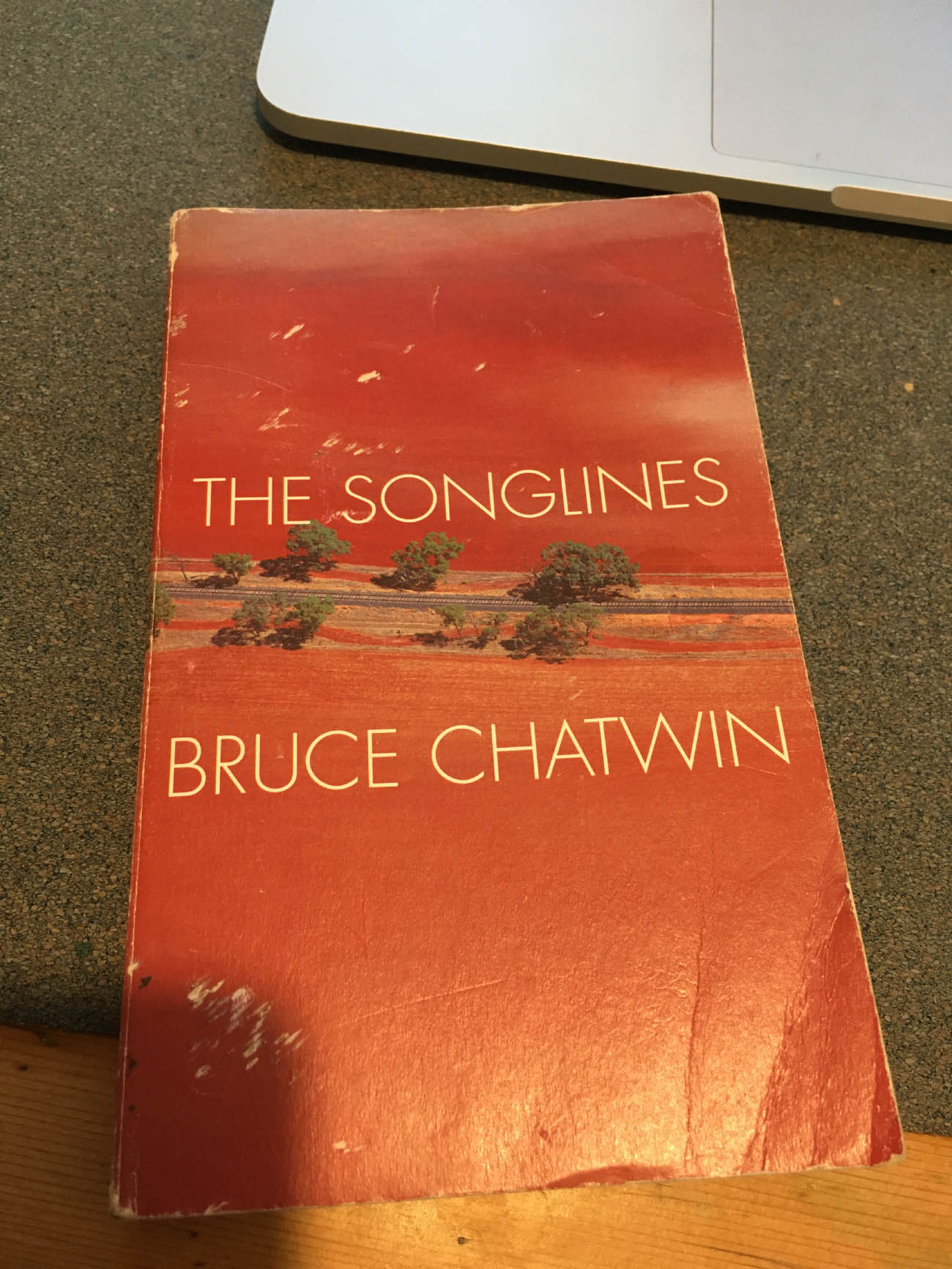
The Songlines was published in 1987, which makes it essentially ancient history at this point. I read it much later, after writing a play about two explorers in a post-apocalyptic desert arguing about whether a line of burnt-out cars indicated a path to follow or not, when various people in my family told me my play was "basically just The Songlines". They were wrong - my play had more jokes in it, and ends on a gunshot - but they were also right; the play, like the book, was about route-finding, about journeys, stories and lines.
It's a sort-of anthropological book; it describes a journey by the author into Australia. I can't remember what happens on this journey and it's not terribly important. But the book culimates in a collection of thoughts about walking: what it means to walk and how people know which way to walk.
It proposes that us humans are not defined by being "the animal that talks".
We are "the animal that walks".
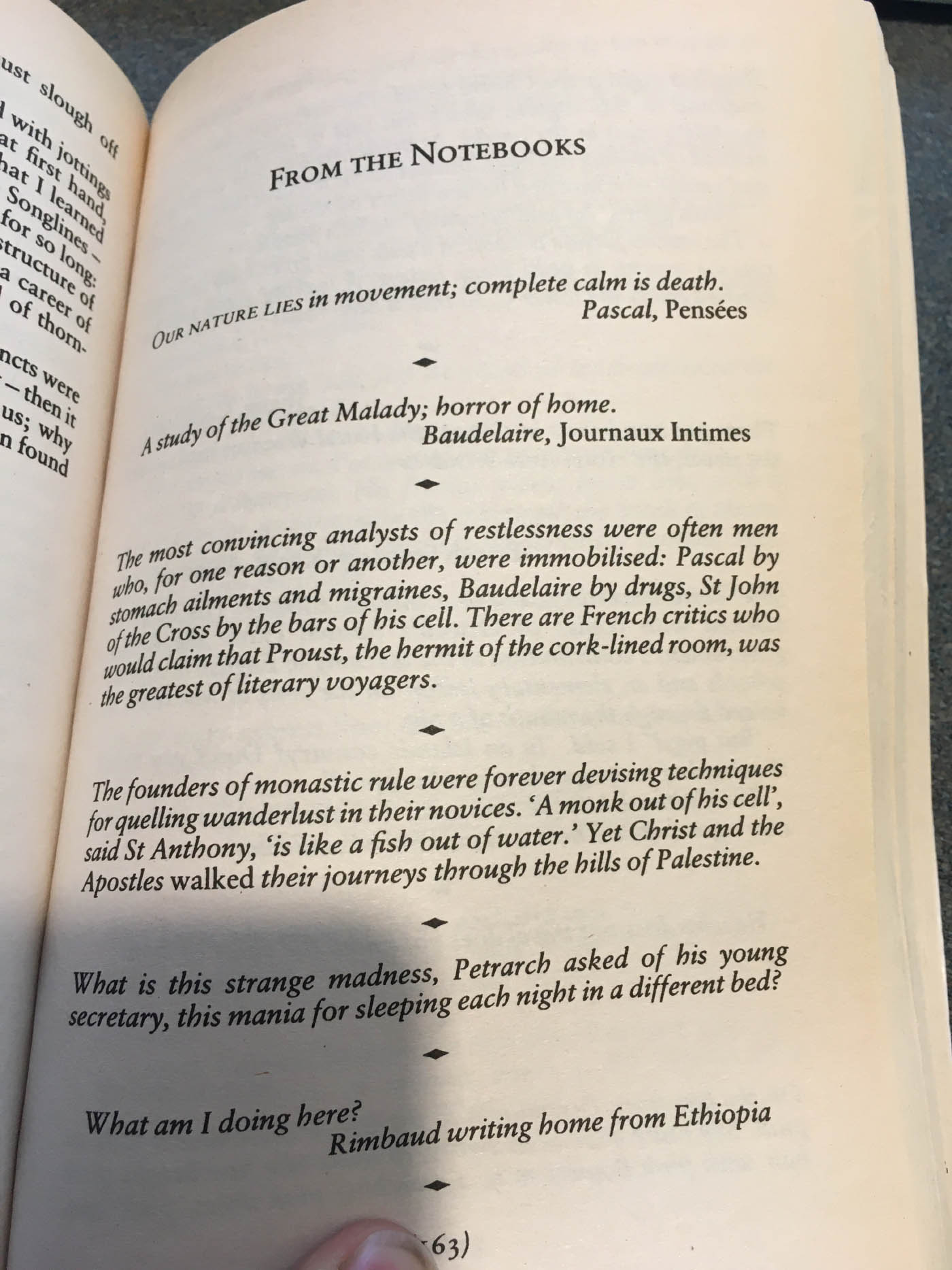
That sounds ridiculous but it isn't, it's really fascinating.
(This, by the way, is what I think anthropology is supposed to do: take something really mundane and then make you realise how fascinating and bizarre it is. My favourite example of that is "the three-second rule"; the one that allows you to eat crisps which have fallen on the floor of a pub, but only if they've been there for three seconds or less. After that, they become instantly disgusting and filthly. That's sensible, right? Wait. No, it's not. Anyway.)
The Journey of a Story
One of the things discussed in The Songlines (which, I should warn you, may or may not be true, and may be massively oversimplified) is the way Aborigines use stories - songs - as a way to navigate the enormous terrain of the Australian interior. Without maps (there being no paper, presuambly), the traveller recalls a tale, the major beats of which take place at major landmarks along the route. Here is the tree where the story begins; here is the rock where it continues; here is the river the characters crossed; and here is the ending, right where we wanted to go. The stories are the journey, and the journey repeats and reinforces the story.
The sounds ridiculous, doesn't it? Except, only, how many times have you walked through a city and said to your friend, "we go past the place where we met so-and-so; then turn left at that tree you tried to climb but feel out of; then right at the cinema complex where you were stood up that time; and then it's at the end of the street."
The Joy of Walking
This game is a journey about stories, that form the story of a journey. It's also about how glorious, how basic, how simple and how delightful it is to walk.
And when walking is truly delightful, one breaks into...
... ah, now, but that would telling.

The Call of the Wild!

Every narrative project has to start somewhere - with something you're trying to hit. The highland game's different than most of our previous games because we're trying to hit a feeling. (You'll know it when you see it, I think.) So the narrative part of the game has a different job than it might sometimes: get out of the way quickly, then hold the game up high.
This is a game about going out into the wilds, and not knowing if you're coming back. Which sounds super dark and scary: but this isn't a scary game. You aren't going to get eaten by wolves. (You're more likely to turn into one yourself, perhaps. We'll see.)
So - who are you, and why are you doing it?
We tried some ideas that were adventure stories. After Hitchcock and the 39 Steps, you're a spy, crossing the hills to avoid escape. (Joe pointed out it could almost be called "Over the Highlands" at that point. It's a fair cop.)
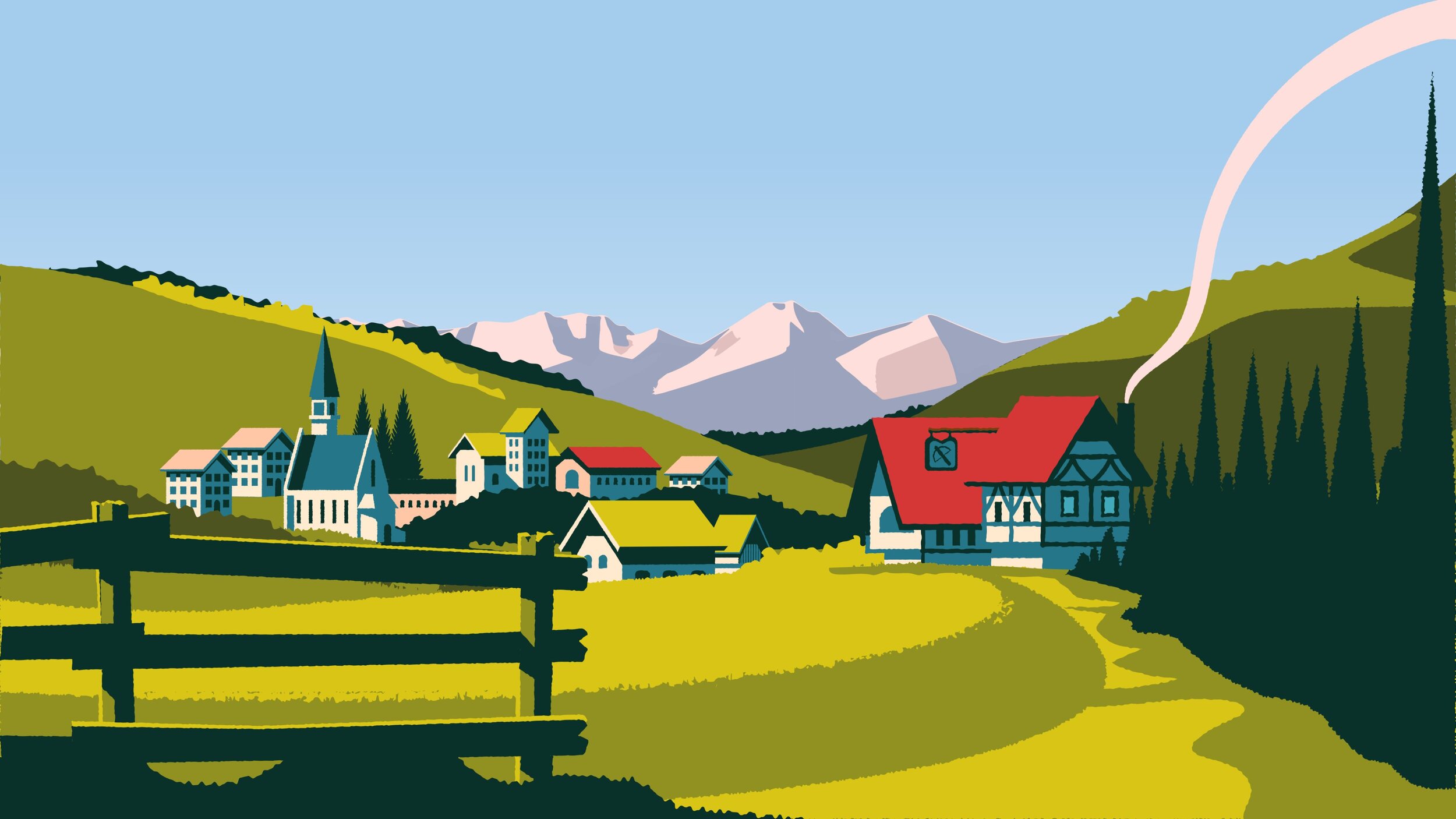
Something more grounded then. You're a teenager and you're running away from home. That's almost this game. But if you're running away from something it's not quite the same as running towards something, is it? With every step away from something the tension recedes and only regret or "oh God it's chasing me" can step in. With running towards something, you can anticipate. You can wonder what you'll find. And - in classic inkle style - you can worry about being late.
So what's across the Highlands that's worth running towards? And who runs? And while you're running, what do you find?
I've done a lot of hill-walking - not in Scotland, as it happens, but in the Borders. For me, the thing I always loved is seeing a peak and striking out for it, getting there somehow or other. The stories of a place are there to help you arrive, and help you set out for the next hill.
What's in the Highlands waiting to be found? And will it pull you off your journey, or push you further along?
Ah, now that sounds like the makings of a tale.

Trees and stone skimming
Here's a quick snapshot of what some of the team has been up to this week!
Annie has been starting to paint lots of scenery! We're going to need loads of rocks and trees in the game to make it feel lush, with lots of unique features, hopefully without too much repetition! Here's a few of them:

She's also started creating some tree kit parts that can be combined in different combinations and then animated so that they can sway in the wind:

Meanwhile, Tom has been working on a delightful stone-skimming mechanic. We're experimenting with several activities that feel thematically relevant for the world, and may at first appear to be satisfying but inconsequential toys. However, they will turn out to have genuine impacts will be relevant to the narrative or to the wider gameplay arc.
He has also been working on some level design experiments, and we've been thinking deeply about the platforming aspects of the game. This game isn't like Celeste - it's not intended to create fun out of immense hand-eye coordination challenges. But the risk is, if there's no challenge, then the game could end up feeling a bit hollow and lifeless - without risk, there is no reward. Let us know if there's a game that you think we should try that gets a really good balance here!
Of course, there's a lot more to the game than just platforming - so we don't have to rely on this on its own to keep the player's interest. The other primary ingredients in the mix are the narrative and the strategic planning, a bit like in 80 Days.
And finally, after our call for animators last week we've had lots of fantastic submissions, it's been a pleasure to look through so many beautiful portfolios. We can't wait to see our character come to life in game!

Calling hand-drawn animators!
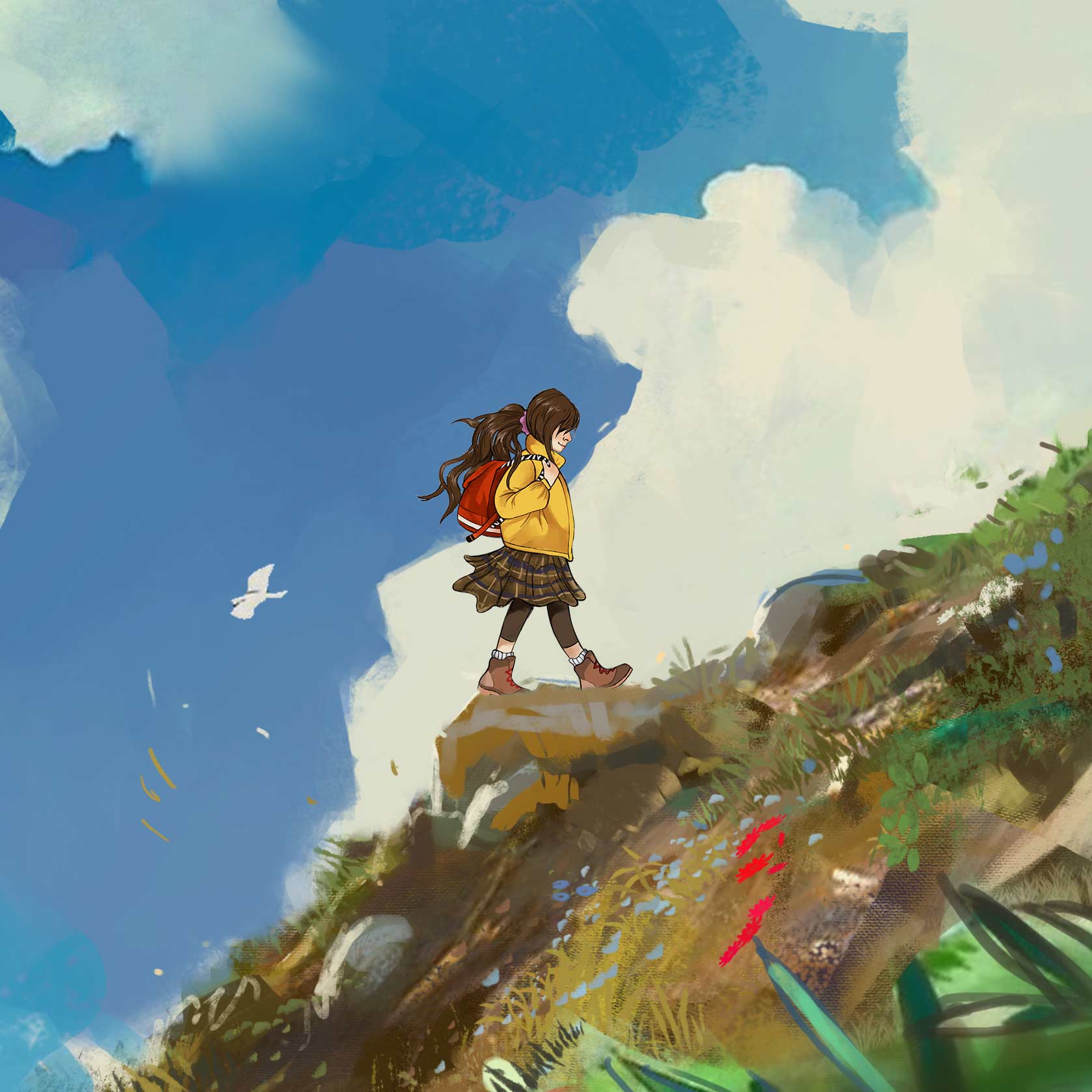
At the end of last year we experimented with using Spine to animate our main protagonist. Our animator friend and colleague Martin (who's been working on his own incredibly-named Schrodinger's Cat Burglar) gave us a helping hand, and started producing idle and run cycle animations to help us prototype the concept with our latest character design.
But as we experimented with Spine and 2d rigged animation, we increasingly realised it was perhaps the wrong direction to be pushing in. Although 2d rigged animation can give you very smooth results, it's also quite limited - for example you can't easily turn your sideways-facing character to look forwards at the camera. The advantages are that once you have a rigged character, it's relatively straightforward to create animations since it's equivalent to manipulating a shadow puppet.
By comparison, hand-drawn animation requires you to... well, hand-draw every single animation from scratch. But in return, the results can look incredible - have a play of Spiritfarer (character art below) if you don't believe me! Hand-drawn animation can add a huge amount of charm and character.
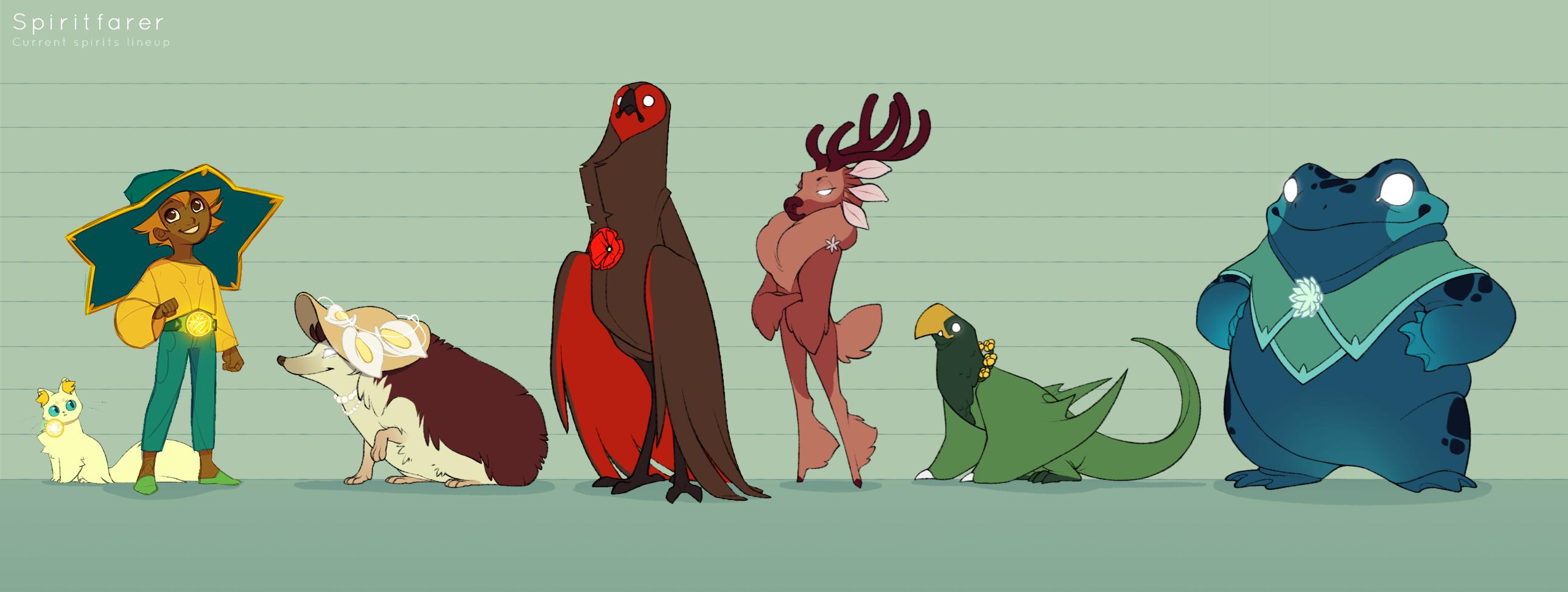
They also seem like the perfect fit for our environment art, which has a painterly aeshetic - we think they will sit together wonderfully.
We have one big problem though - we don't know any traditional hand drawn animators! Annie is our in-house artist and illustrator, and produces beautiful work, but we could do with some help producing pencil test frames that she could do the finishing work on.
Work with us!
UPDATE: We have now found our animator, thanks to everyone who applied!
So, here's the plan: if you're a freelancer and you think you'd like to work on our highland game (or know someone who'd be a good fit), please get in contact. Here's how we'd like to run it:
- We strongly encourage women, BAME and other minority background candidates to apply.
- A timezone closer to the UK is preferable. The work will always be remote.
- Send an email to info@inklestudios.com with "Highland Animation" in the subject line, and a link to a portfolio or sample animation work.
- If you seem like a good fit for the project, we'll ask you for a fully paid art test (we're likely to ask for a few of these from different people, assuming we get enough responses).
- We make a beautiful game together.
Happy New Year everyone; may this one be better than the last!

Character Concepting - Part 2
[ TV ANNOUNCER VOICE: Previously on Character Concepting! ]
For year we'd been really happy with our character design sketch:

But when our art director Paul came on board, we started to revisit the character design so that she would fit better into the overall art direction. This design was a bit overly cartoonish and didn't fit with the more realistic background art so well.
She was also not entirely fitting with the narrative that Jon was starting to weave. We decided we needed a character who was a bit more grounded. She exists in a world that can be beautiful but also unforgiving; she has a difficult journey to make.

We loved this new direction. And so we started to narrow down the design:

But those were a bit too young. We felt like our protagonist was more like a 14-15 year old.
A pair of socks and some hair experimentation later, and we were all really happy with the design. We've also being going back and forth on whether the art should have (possibly sketchy) outlines, or be clean.
Here's a version with thin outlines. What do you think?


The art of the highlands
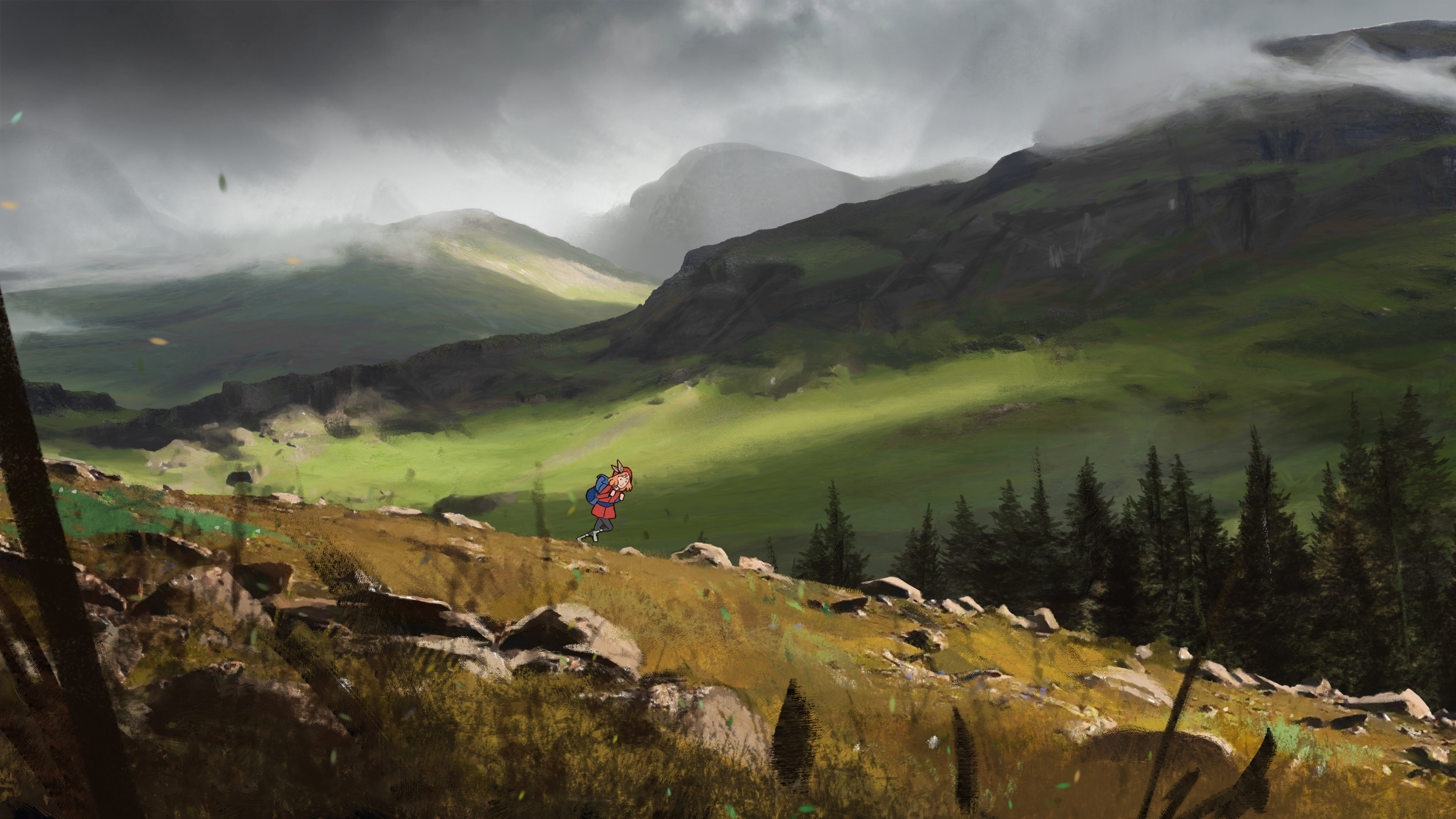
It's really important to us that our game strongly conveys the unique feeling of the highlands. There's a strong distinction that you feel being in the Scottish mountains compared to say, the European alps or Yosemite National Park. Scottish mountains aren't the highest, the jagged-est or the pointiest. But they have a darkness and weight to them that's only really shared with places like Iceland or perhaps parts of Scandinavia. They can be very lonely too - the further North you go, the further from civilisation you'll find yourself.
Our players don't all need to be fans of the Scottish highlands of course, even if we are! The point is to create a unique and strong aesthetic that's not just "generic green hills and rocks".
Part of capturing that aesthetic has been about finding an art style that can reflect it with authenticity. We wouldn't want to go with anything too bright or cartoony, so we think a level of stylised realism could do the trick.
The reason we approached Paul first about helping us out with art direction was that his work is both painterly yet has a sense of effortless realism; he's one of those concept artists who can convey a lot with a few important brush strokes.
We think his concept art above is a fantastic example of this! He's also produced an animated version of it that demonstrates parallax, and we'll share that in a future update.
When Paul first joined the team, he started off with a few loose studies to get a sense of the environment: the different times of day, weather and the textures in the foreground. These are a bit looser than our final intended art style, but the looseness is a good demonstration of how much can be achieved with so little!
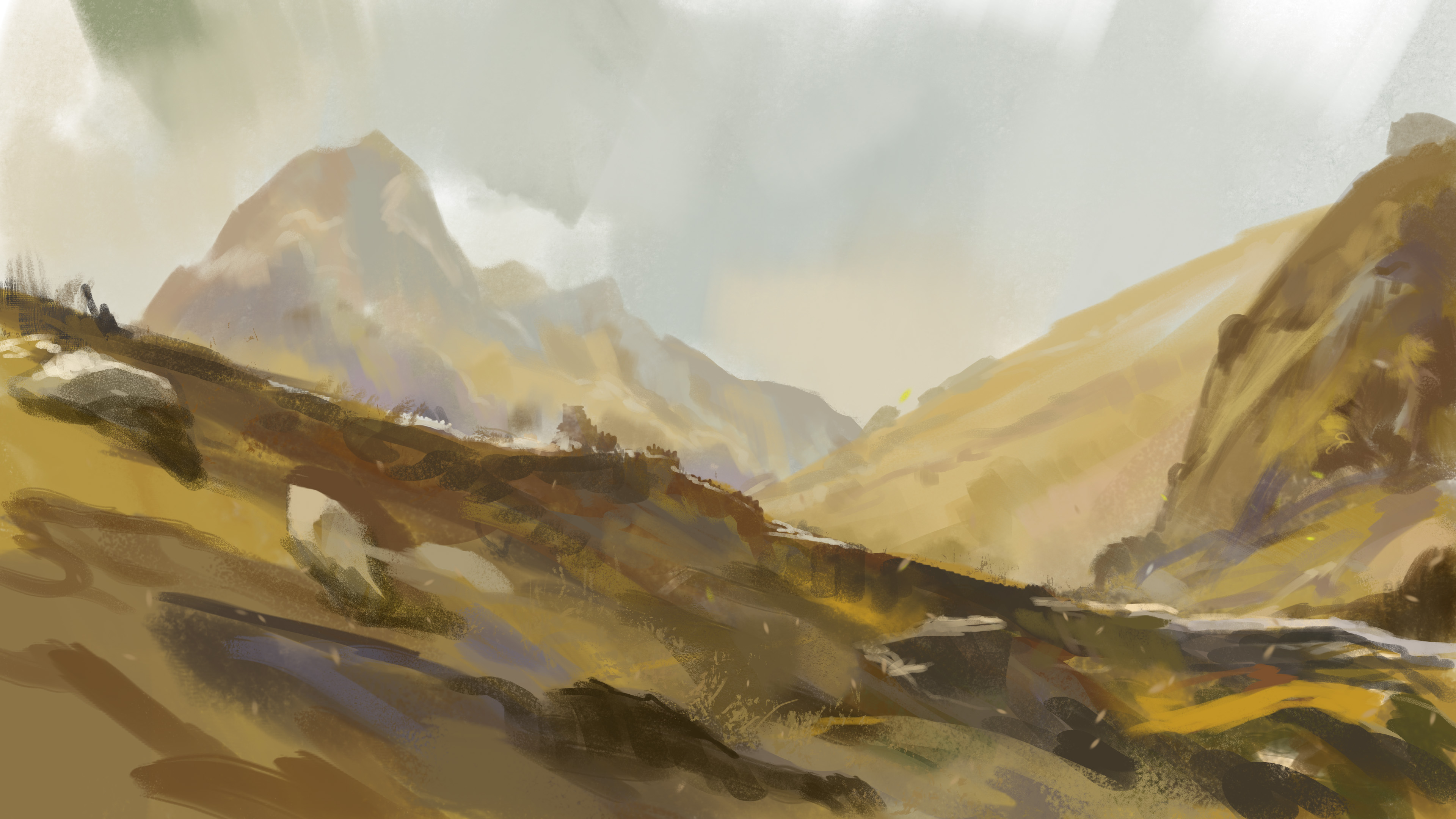
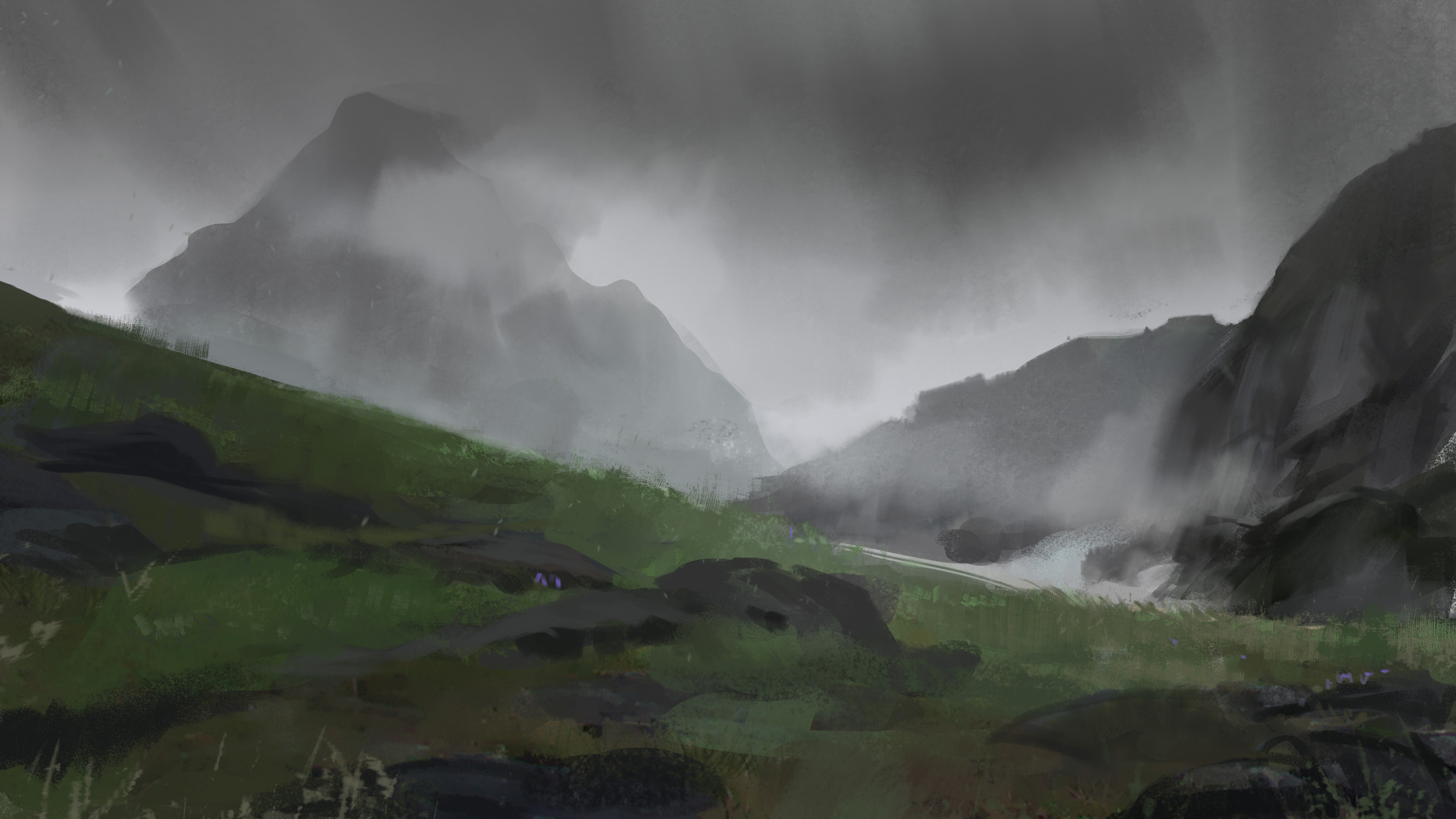
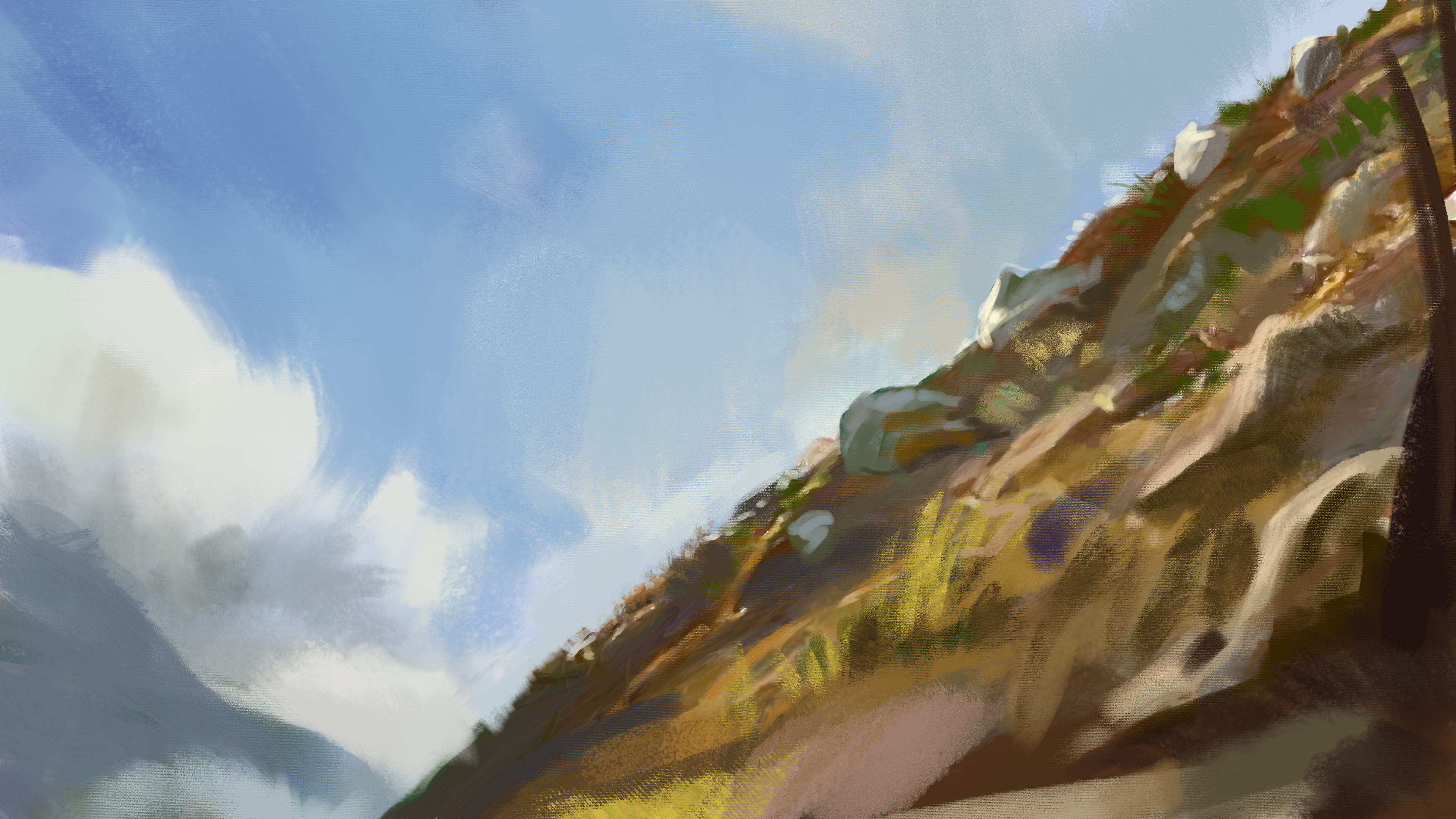

Finding an art director
In all of our past games the art direction has been primarily my (Joe’s) responsibility. I’m a bit of a jack-of-all-trades-master-of-none, and although I love art and I have artistic opinions, I’ve often been stretched a bit thin, especially on Heaven’s Vault.
One thing we decided very early on is that our highland game has to be absolutely gorgeous, so on this project, it was time to find some outside help - someone who could help us define a beautiful, consistent look for the game.
We were keen on a painterly aesthetic, to give the sense that you’re playing inside a rich, lush landscape painting.
Our first choice was Paul Scott Canavan. He’s an exceptionally talented illustrator and art director. Oh, and he's Scottish.
Just take a look at some of the gorgeous work from his website:

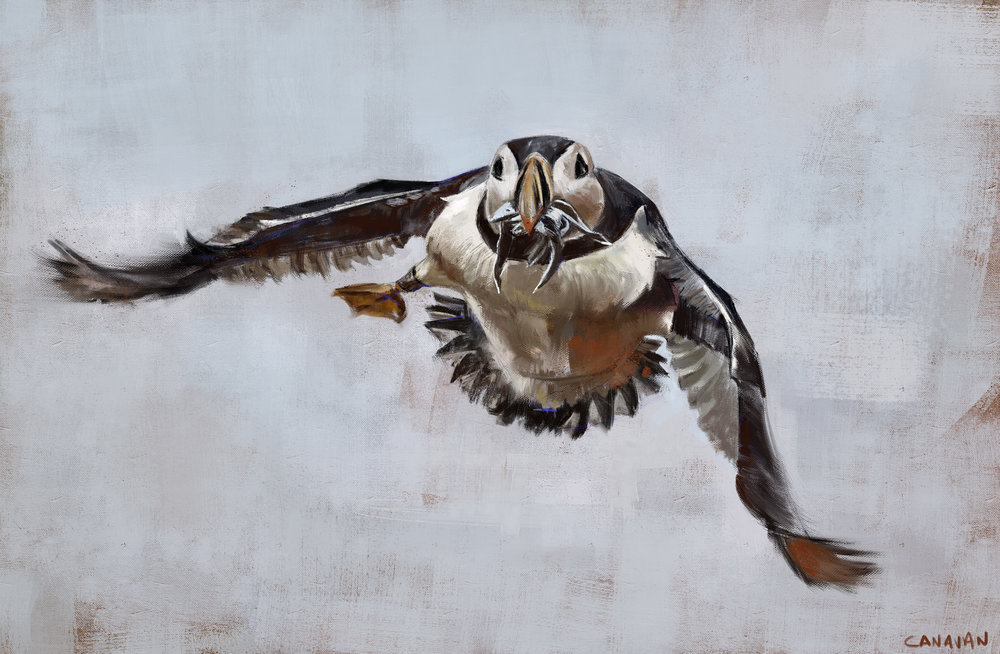
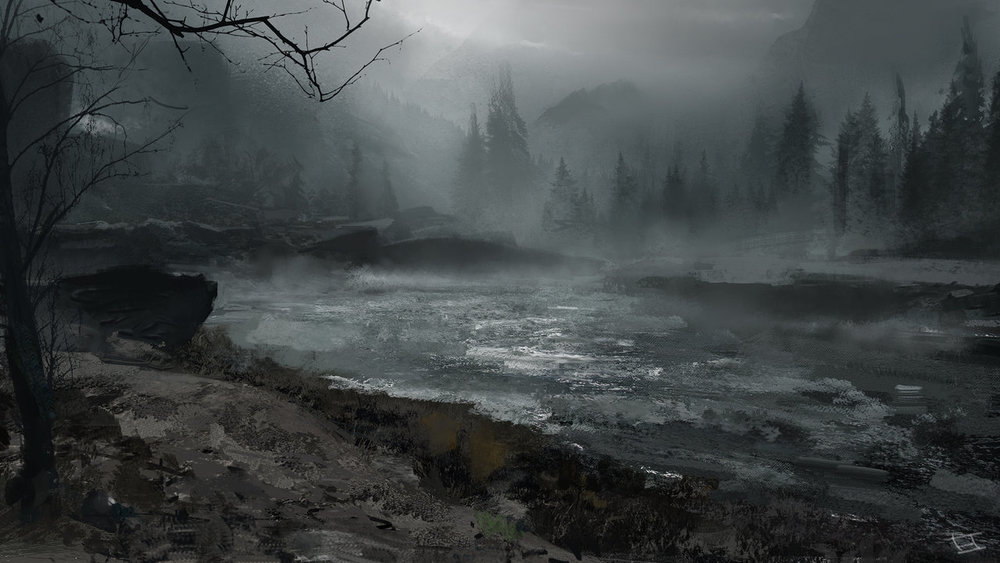
So, we dropped him an email. Just a few minutes later, and we had an enthusiastic yes! He loved the concept and was really eager to work with us to make it a reality.
Paul isn't just a brilliant illustrator; he's been doing a great job of deconstructing the game's art style, breaking it down so that we can work together to build it back up in-game out of the fundamental pieces.
By the way, the key art at the top of this page is his - and it’s the overall look we’re aiming for on this project. We can't wait to show more of what we've been working on together!

Character Concepting - Part 1
We started designing the look of our protagonist back in the summer of 2019, while working on Pendragon.
Here are some of Annie's lovely early sketches:



For a long time, we had settled with the following design. In fact, we've had her in-game for a while, with some early prototype animations:

We've been doing some new work on the character design since then. Watch this space for Part 2!
Update: Part 2 is now here

The story so far
Welcome to this brand new little update blog for our as yet untitled game that's set in the Scottish Highlands. (Okay, we have a proper name for it, we're just not ready to say what it is yet!)
First, let's get up to speed. What kind of game is it that we're making?
In some ways it's very similar to our previous games - it's about travel, it's replayable, and has a strong branching narrative.
In other ways, it's very different. This game has a side-on perspective and has 2d platforming elements, which is very much uncharted territory for us!
Something else that's very different: we're planning to be more open with the development process than we ever have in the past. We're going to try and post regular updates. So please hold us to account if we haven't posted in a while!
That's it for now! Watch this space for more...




